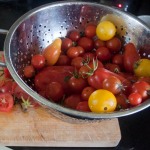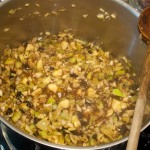 Welcome to March, and spring is (or at least should be!) just around the corner. Last night, the first ‘Gardeners’ World’ of the year aired on BBC2: you might say that the official ‘starting gun’ of the gardening year has been fired.
Welcome to March, and spring is (or at least should be!) just around the corner. Last night, the first ‘Gardeners’ World’ of the year aired on BBC2: you might say that the official ‘starting gun’ of the gardening year has been fired.
We’ve had some exciting weather here in Cornwall to start the month, with heavy snow and freezing temperatures, so much so that we actually got to go skiing on our field! I can’t help but wonder if we’re the first people ever to ski in this little corner of the county? But if the weather outside can’t make up its mind, inside, we’re making plans for the new growing season, and our first seeds – tomatoes and chillies – are sown and have already germinated.

This year, I’ve had a rethink of the approach to my veg growing. Out go the F1 hybrids, as you can’t save seed from them and they leave me dependent on buying seed from a progressively smaller number of commercial seed producers, most of which are divisions of the sort of large multinational agrochemical companies I would rather not be supporting – even in a small way – with my hard-earned cash. In their place, heirloom varieties with a good track record of performance in garden growing situations, which hopefully I can save seed from for future years, improving the sustainability of our growing while reducing my annual seed bill.
It begs the question, of course, of why F1 hybrids are so popular? As I see it it’s a combination of things – not least, I’m afraid, a cynical preference for what are effectively ‘copy-protected’ seeds on the part of the seed sellers, as the offspring of F1 hybird varieties will not come ‘true to type’ and will often have very inferior production characteristics. But besides that, F1 plants are often that bit more vigorous (so called ‘hybrid vigour’) and are very consistent in their growth. Want ten (or a hundred, or a thousand) identical tomato plants, which will germinate together, grow at very much the same pace, and produce identical-looking and consistently sized tomatoes? If so, you need hybrid plants, as there will always be a bit of variability from plant to plant in open-pollinated heritage varieties.
Who cares about that? Commercial growers, mostly – while I can see that it might have some benefits to the produce showing fraternity (as the judging at vegetable shows is obsessed with the consistency of the vegetables presented – three or five near-identical peas will always beat bigger or better inconsistent specimens), it’s actually the case that most keen vegetable showers are keen to maintain and improve their own varieties, keeping seed from the best producing plants to improve their performance from year to year, something which is impossible for F1 plants.
Also out are dwarf peas and beans – I’m sure they have their use, but darned if I can think of it? I have a feeling that, again, they were developed to allow commercial, field-scale growing of beans without the need for supports, which can then be harvested by machine. But for the individual gardener, what a waste of growing space they represent, if you can instead grow them upwards on a great big wigwam and get a far bigger harvest from each individual plant. They’ve become so prevalent in the seed catalogues these past few years that I keep finding I’ve bought dwarf bean seed by accident. This year, no more – if it can climb, it will climb!
 A few years ago I started experimenting with soil blocks for seed starting. The mix I developed then – 4 parts peat free multipurpose compost mixed with 1 part vermiculite and 1 part topsoil (harvested from our generous numbers of field molehills!) continues to serve me well. We’re as strictly peat-free here as we can be – though it can be hard to source reliably peat-free plants.
A few years ago I started experimenting with soil blocks for seed starting. The mix I developed then – 4 parts peat free multipurpose compost mixed with 1 part vermiculite and 1 part topsoil (harvested from our generous numbers of field molehills!) continues to serve me well. We’re as strictly peat-free here as we can be – though it can be hard to source reliably peat-free plants.
The blocks work extremely well for mid-sized seeds that are single-planted, or for little seeds planted in small clumps. The 2 inch blocks that I make are obviously little use for anything bigger – beans, peas, and pumpkins / squashes still get started in 3 inch pots. But they’re a great way of reducing the amount of plastic we use in the garden, as they fully replace module trays – and my experience is that seeds started in these blocks transplant outside really well, with almost no ‘check’ to their growth when relocated – probably due to the minimal handling and root disturbance, combined with the fact they are already accustomed, thanks to the soil component of the mix, to the soil conditions here.
This year my chilli varieties are Santa Fe Grande, Ring of Fire and Maule’s Red Hot – sourced from US-based heirloom seed supplier Baker Creek Seeds. I’ve chosen these three specifically because they’re short-season varieties – one of the problems I’ve had with chillies in the past, growing outdoors in the tunnel, is that I’ve grown fantastic plants but there just hasn’t been enough time for the chillies to ripen before winter. With a bit of luck, these should fruit and crop earlier. Having decided on these, sown and germinated them, I was introduced last night on Twitter to a traditional African variety called the Fish chilli and I’m caught – it’s a beautiful variegated plant that produces variegated chillies! – I ordered some seed last night, so let’s hope it arrives quickly and is able to catch up for the missing growing weeks.
My tomatoes are Cuor Di Bue (Oxheart) and San Marzano, from Italian seed suppliers Franchi. The Cuor Di Bue packet, unusually, advised me to sow under a waxing crescent moon – which, as it happens, I did, however unintentionally! Joining them, from Baker Creek, Rutgers, A Grappoli D’Iverno (Italian winter grape), Brad’s Atomic Grape (a bizzare-looking, streaked, technicolour variety), True Black Brandywine and Black Vernisage. That makes seven varieties, which is three too many. Last year I only grew four (Oxheart and San Marzano, along with Golden Sunrise and my Grandma’s old favourite, Moneymaker) and decided firmly that it was a good plan and I’d be strict with myself in future and not over plant… What can I say, I’m a sucker for a seed catalogue!
I’ve had great, quick, strong germination this year – the tomatoes were almost all up on day 4, and the chillies broke the surface between days 10 and 14, really brisk germination and better than I’ve had in the past. I put this down in large part to my new gardening gadget purchase of the year: I’ve invested in an LED grow lamp for my germination set-up, to add to the two cheap heated propagators that have been my dependable friend for years now.
The cost of LED lamps has crashed recently, and my panel cost me less than £20, with very little electrical running cost, either – LED lights are very efficient. When previous grey springs have produced weak, leggy, lanky seedlings, this year’s plants seem strong, are growing vigorously, and are a lovely dark green colour. I’m particularly impressed with the effect on germination, which I hadn’t anticipated. Better still, my baby plants are no longer jammed into window sills all over the house, but instead can sit on a bench in the back hallway, where the temperature is more stable and they’re not so at risk from low overnight temperatures. It also feels less like I’ve transformed my entire home into a grow-house. At this rate, I’ll need to buy a second panel to cover more of my growing bench!
I’ll be back to keep you posted soon!
P.S. Those of you who are long-time followers of the blog will remember Dave the dog, our wonderful Rough Collie, who made regular cameo appearances here. I’m sorry to have to tell you that we lost Dave last year, he was thirteen, not a bad age, and unfortunately his legs eventually let him down. We miss him very much.
But all clouds have a silver lining – and this is ours: she’s called Rosheen, has rampaged into our lives like a little tricolour whirlwind, and I’m sure you’ll all be very familiar with her antics soon!
Read more from the Country Skills blog >






 3 large cloves of garlic
3 large cloves of garlic

































































